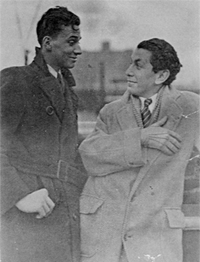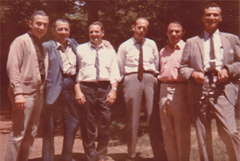Gilbert Roller (1915-2004)
Gilbert (“Gil”) Roller was an artist, musician, photographer, film-maker, and all-around Renaissance man; He was also a reluctant medium and the central figure in the teen-aged séance group called “The Bindelof Society.”

Olga Roller on stage at the Schubert Theater in Victor Herbert’s Eileen
EARLY YEARS
Gil’s mother, Olga Roller, was a beautiful singing actress who performed in operettas and Broadway shows in the early 1900s. She had a great interest in psychical research and owned many scientific books on the subject. She often participated in séances back-stage or in hotel rooms on tour with other performers such as her friends the Dolly Sisters.
Olga probably had some psychic talent, which she most likely passed on to her only child, who was extremely close to her and joined her when she was on tour.
Gil’s step-father, Eddie Fink, was a gregarious pianist, who played for years in Manhattan’s Luchow’s Restaurant, at that time a favorite gathering place of show-biz and other New York celebrities. His relationship with Olga was loving but tempestuous, with frequent fire-works in which Olga would break dishes and Gil would scream in terror.
LIZ, THE POLTERGEIST
When Gil was about 11 or 12 strange things began to happen in their apartment: Olga’s hairpins would be flung around. Sometimes they would hear them hitting the back of the closed bedroom door, when nobody was inside it. They named the force “Liz,” and would say aloud, “Liz, throw something,” and they’d hear the “zing” of a hairpin zipping by and hitting a wall.
Knobs from shoe-trees also started flying. Oatmeal was scattered over the carpet. A heavy metal toy train, one of Gil’s prized possessions, was torn to pieces inside a cabinet. On returning to their empty apartment the family found the words, “GO, GO” crayoned on the walls in letters four or five feet tall.
THE FIRST SÉANCE
After one particularly vexing fight, Olga decided to take “Liz’s” advice and left, taking Gil with her. They stayed with some friends of hers who were evidently interested in sitter groups, and they decided to have a séance, including the young boy since he was there.
After sitting in the darkened room for a while, the curtains started to blow inward although the windows were shut. Then a large easy chair on the side of the room began to move toward them. They ended the sitting! This was Gil’s first experience at a séance.

Gil Roller and Larry Levin at the time of the Bindelof sittings
ENCOUNTER WITH LEN—AND LARRY
A couple of years later, Gil, who had been privately tutored and so knew few people his own age, met a precocious neighbor, a year younger than himself, named Leonard Lauer. Lenny attended a high school for intellectually gifted boys and in a kind of “I know more than you do” contest, was introduced to Olga’s library of scientific books on psychic phenomena. Impressed by the quality of the works, he convinced Gil to try sitting with him to see if they could get table movements and raps.
They met in secret, just the two of them, at an ordinary bridge table in Lenny’s apartment while his parents were out, and eventually got the table to slide, tilt, and move around the room.
Len invited another fellow student, Larry Levin, to join them and the three succeeded in getting the table to levitate.
THE BINDELOF SOCIETY
More students were invited. One of the others who joined was Montague Ullman, whose ambition was the study of medicine. Because of his experiences in the group, he became a psychiatrist and parapsychologist who did important work, especially in the study of dreams, and investigated claims of healers. (It was he who sought out Nina Kulagina in Russia and brought back the film that inspired Felicia Parise.)
Gil and the boys set up a regular schedule of meetings on Saturday nights at the Roller’s apartment, crowding into Gil’s small bedroom. Now they worked with a small night stand with an open shelf. They sat around the table, each boy touching the fingers of his neighbors on top of the table, and touching or stepping upon the feet of his neighbors on the floor.
Gradually they were able to obtain the classic phenomena of raps, movements and levitation, but they, growing impatient with the slow spelling out of the alphabet and waiting for a rap to indicate letters in order to get “messages” asked if they could get written messages. The raps signaled “yes,” so they put some sheets of paper and a pencil on the open shelf and waited.
WRITTEN MESSAGES
They could hear the pencil scratching on the paper, falling down, scratching again, and finally writing faster than any of them could do normally in good light. When they heard the pencil slapped down, they’d jump up, turn on the lights and retrieve the paper. The messages they received were sometimes short answers to spontaneously asked questions, and sometimes page-long messages.
The “writer” eventually identified himself as a Dr. Bindelof, who claimed that he had died but wanted to continue healing people.
Much later in their meetings the boys asked if they could have a picture of the “Dr.” and were given instructions for exposing the glass emulsion-covered plate (this was before flexible film) in the dark with the camera pointed at the center of the bare table. What appeared, when the boys developed the plate in Gil’s makeshift bathroom darkroom, was the “thoughtograph” illustrating the cover of my book.
READ THE FULL STORY
Many more phenomena than I can mention here developed in this extraordinary group of young people. The full story of Gil, Larry and the others and their discoveries in and out of the séance setting makes up the first third of my book The Spirit of Dr. Bindelof: The Enigma of Séance Phenomena. You can read the first chapter here.

Reunion of surviving members of the Bindelof Society. From the left: Montague Ullman, Larry Levin*, Leonard Lauer*, Howard Frisch, George Keiser and Gilbert Roller*
* The original three
THE BOYS GROWN UP
Montague Ullman preserved the minutes from the sittings, the messages, photos and so on and also sponsored reunions of the surviving members to reminisce and iron out any discrepancies in their memories.
The only one of the group who was able to elicit movement and some levitation in adulthood was Gilbert Roller. They all pretty much agreed that Gil was the “medium” or center of the force most likely drawing on the abundant energy of the other healthy teenagers.
Gil went on to have a successful life as an artist, a TV film-producer, and in several other endeavors. He helped promote the work of his talented sculptor wife, Marion Bender Roller, wrote stories and plays, and taught a course in “Paramechanics” (PK) at Manhattan’s New School.
WAS THERE A DR. BINDELOF?
Most of the original Bindelof group came to believe that Dr. Bindelof was a product of their—especially Gil’s—subconscious. All, except Larry, who carried with him, until his death at nearly 100, a small picture of Dr. Bindelof, who he felt was a sort of guardian angel to him throughout his long life.
Ullman searched at the time and later for any trace of a physician by that name but came up empty. I searched by computer and found no evidence that the name ever existed. My sense is that “Bindelof” was unconsciously derived by Gil from the German—his mother was Austrian and his nanny spoke only German—and Russian. His mother’s name was Olga after all, and Gil’s favorite composer was Rachmaninoff.

Gilbert (“Gil”) Roller ca 1980
I found a short story among his papers after his death that illustrates very poignantly this quality of attempting to heal. (Read Insights here)
I said a sad goodbye to Gil a week or two before his death from cancer on October 20, 2004 at the age of 89. We knew it was the last time we’d see each other. He was very ill and weak but kissed the back of my hand as I held his and with a soft smile assured me he would still be around.
I’ve tried to make sure that he and his work still are, and will be, for many years.

See also: Direct Voice Phenomena
The Bindelof Material: Gilbert Roller and Montague Ullman
discuss their experiences of a half-century earlier at the Parapsychology Foundation in New York.
Read about other “outside the séance” people:
Felicia Parise • Gilbert Roller • Kenneth Batcheldor • Nina Kulagina • Sir William Crookes
Ted Serios • The Philip Experiment • Uri Geller